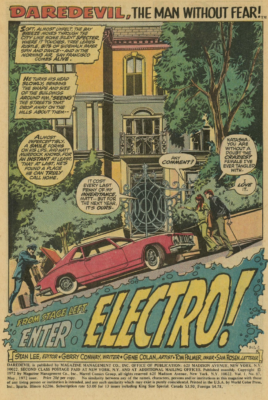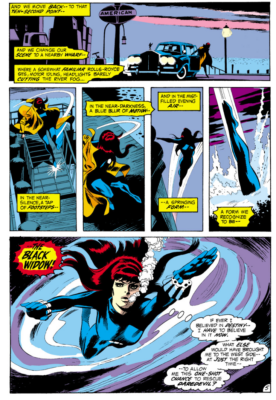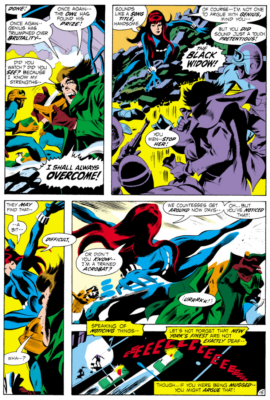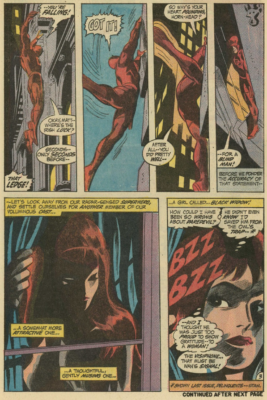Daredevil and Black Widow Fight Villains and Bittersweet Feelings By Anthony M. Caro
Why did Daredevil team with Black Widow in the early 1970s? Here’s a simple answer: to fight crime and increase sales. Whether the sales figures hit what Marvel’s number-crunchers wanted is lost to history. No matter since the historical lens reveals that the Daredevil/Black Widow team-up in the 1970s was a creative triumph. The team-up lasted from Daredevil #81 to #124, and the commencement of the superheroic and romantic soulmate duo is worth revisiting. The Gary Friedrich-created Blofeld-esque villain Mr. Kline (The Assassin) serves as a reliable linchpin for a direction-changing story arc. Daredevil—the hero and the monthly comic book—needed a change in direction, one Black Widow helped provide.
Marvel Sales and Daredevil’s Lament
Marvel Comics and revisionist history seem inseparable. A commonly spun version of events suggests that immediately after Marvel debuted The Fantastic Four and Spider-Man in their respective books, the House of Ideas lit the industry in a fireball and captured the market. In reality, Marvel Comics’ climb was far slower. Marvel achieved great success by the late 1960s, but the 1970s would turn rocky. Equally revisionist is the notion that certain books didn’t do as well as they did. Suggestions that Daredevil hung on the lower rung of sales and only gained a strong following when the legendary Frank Miller run prove inaccurate. In 1968, Daredevil cracked the Top 40 of industry-wide comic book sales, reaching #23 on the charts, becoming Marvel Comics’ fourth best-selling title.
By 1969, Horn-Head’s monthly book averaged 245,000 sales, an impressive number, but still 100,000 less than Archie and Me. In 1973, Daredevil dropped to Marvel’s 11th best-selling title, with 168,000 issues on average per month – not a great number, but not so low that the figures couldn’t be turned around. Overall, Marvel’s sales from 1973 looked concerning, as they were somewhat anemic and appeared to be trending downward. [Please see the references at the end for more information about Marvel’s sales numbers.] Marvel chose to tap into the team-up approach similar to Captain America, forming a duo with the Falcon, likely feeling Daredevil could maintain or, hopefully, increase sales by turning the book into a team-up series. Black Widow enjoyed a run in the Amazing Adventures anthology series. Appearances in eight issues didn’t instill enough confidence to give the character a monthly solo title, but feedback was apparently positive enough to believe Black Widow could help reinvigorate Daredevil. The team-up revitalized and reinvented Daredevil while keeping true to the established character and allowing Daredevil and Matt Murdock to evolve.
Daredevil No Longer Swings Alone
The Marvel Comics of the late 1960s and early 1970s sometimes dipped into experimentation while remaining true to essential elements of comic book storytelling. Writer Gerry Conway and artist Gene Colan’s approach to Daredevil pushed the experimental approach further by creating a mix of traditional hero vs. villain action, soap operatic storytelling, and trippy artwork. Reading a Daredevil comic from the era isn’t like being a “first-person reader.” Instead, the experience feels like hearing a third party incredulously relaying what they saw, with the soap-operatic dialogue and neo-dreamscape art suggesting a witness trying to make sense of what they don’t believe they witnessed. The approach worked well with the underlying social changes of the early 1970s in the backdrop. Black Widow, a feminist hero, effectively guided Daredevil in a new direction. Black Widow symbolically and literally saves the titular hero in Daredevil #81 (November 1971), which features the misleading title “And Death is a Woman Called Widow.” The title is obtusely ironic since Black Widow saves the hero from drowning and breathes new life into the title by helping the comic find new footing. The women’s empowerment subtext has company in the storytelling, but the secondary subtext isn’t concerned with liberation. The strong, independent Black Widow also plays to male readers’ fantasies of a female paramour who shares traits with a male hero they idolize. Daredevil and other Marvel heroes of the era connected with readers because they possessed enviable superpowers and suffered from human problems readers understood.
Like other Marvel heroes, Daredevil has superpowers that are far more attainable in real life. He’s a pugilistic, athletic acrobat in tune with his natural senses – skills and traits that a motivated human could mimic with a physical fitness routine. While his powers are highly exaggerated in true comic book form, attainable versions exist in the real world. Black Widow has skills similar to Daredevil but does not have the fantasy radar sense power, which makes her a more realistic hero, one with abilities more attainable in actual life. Such a hero is well-suited for Daredevil readers since she complements him. Black Widow also has hang-ups, but she handles them better than Daredevil, giving her a levelheaded quality that exceeds her partner, one of the most levelheaded superheroes in Marvel comics. She’s the girlfriend the older male readers clamored for, an exaggerated depiction of an idealized paramour. While that might not fit into the liberation element, it is a description not far removed from how some (then) readers saw her since the book was borrowing elements from romance comics. Weaving heavy romance themes into a superhero book will turn the title into a part-romance monthly.
Daredevil Gets a Lifeline
Issue #81 begins after the previous cliffhanger left Daredevil unconscious at the bottom of New York Harbor. Arch-nemesis The Owl may have finally defeated the hero, as Daredevil can do nothing to save himself. Black Widow knows he’s in trouble and dives into the water to save him. Daredevil later returns the favor by aiding Black Widow during a confrontation with The Owl. However, Daredevil collapses after the battle, revealing Black Widow to be the more resilient hero in the issue. The story progresses slowly, with Black Widow playing a prominent role in saving Daredevil at the beginning and returning to help him dispatch the villain at the end. The slower progression is atypical for comic books of the time, although the pacing makes sense since the title is now shifting to a team-up series that will play out over several years.
What is not atypical is the merry Marvel melodrama that hangs like a weepy cloud over the proceedings. Black Widow saves Daredevil but doesn’t understand why he runs away without noticing her once he revives from his time at the bottom of the Hudson River. Black Widow surmises, “Daredevil must be ashamed…ashamed to owe his life to a woman.” Pop culture forever remains linked to the time of its creation. Comic books can’t swing their way out of that fact. Daredevil #81 hit spinner racks during the days of the emerging feminist movement, a movement that would alter women’s places in American society tremendously. In 1971, Black Widow found herself in a patriarchal fictional world that catered to a virtually all-male audience. Positioning her as a savior to Daredevil helped set her apart from the submissive sidekick role that generally fails to spark reader loyalty to a character. However, Black Widow doesn’t know what’s inside Daredevil’s troubled head, and the hero’s concerns about The Owl’s attempts to do away with him (again) seem secondary to unsoothed feelings toward paramour Karen Page. In the Mighty Marvel Soap Opera Tradition, Karen thinks Matt Murdoch/Daredevil drowned at the bottom of the Hudson River. Hence, she runs into the arms of another while Black Widow vows to keep Daredevil at arm’s length, fearing he’ll end up like other men – dying from bad luck derived from the “Widow’s Curse.” The mix of bringing back a classic villain, establishing a new villain, giving the hero a new partner and new internal conflicts, and playing off of topical cultural and sociological themes allows Daredevil #81 to brilliantly establish the slow burn of a new direction with helpful intrigue. Where are these events headed?
You have to keep reading to find out.
Guest Appearances from the Villain Rolodex
Anyone who thinks comic books are all about aesthetics and creative artistry might be too focused on writers and artists rather than on publishers or distributors. “Now Send….The Scorpion,” the tale presented in Daredevil #82 (December 1971), provides more than an intriguing matchup for the hero. The Scorpion helps draw in Spider-Man readers, as he’s one of the web-slinger’s top foes. (The Scorpion previously provided villainous sales-boosting duties in February 1970’s Captain America #122.) The main villain, Mr. Kline/The Assassin, is not well-known enough to get his image on the cover, but the Scorpion could likely move issues. The villain also provides an excellent way to further the Mr. Kline storyline and help build the relationship between Black Widow and Daredevil. The Scorpion serves as little more than a lackey for Mr. Kline, a role the character previously played for J. Jonah Jameson in The Amazing Spider-Man. In the background, Mr. Kline pressures Foggy Nelson, blackmailing the (then) district attorney. The villain also allows Black Widow to help Daredevil win a fight he has trouble winning by himself, leading to a cliffhanger ending where Black Widow accidentally “kills” the Scorpion. The brilliant slow-burn toward the Daredevil/Black Widow team-up continues as Karen Page drifts away from Matt Murdock. The Karen Page drama may seem like filler material, but a closer second reading reveals how the subplot builds intrigue into where the relationship between Daredevil and Black Widow heads. Since the story ends with Black Widow accused of murdering the Scorpion, readers discover the heroine’s appearances are more than the standard guest shots.
Prelude to a Team-Up
Turning back the storylines a few weeks earlier takes the reader to the debut of Mr. Kline in Daredevil #79 (August 1971), a solid issue featuring the cool new villain, the Man-Bull. Written by Gary Friedrich and plotted by soon-to-be new writer Gerry Conway, the story foreshadows the needed coming intrigue of the Daredevil/Widow team-up. Needed is not an exaggeration. While the Man-Bull story arc is outstanding and hits several valuable elements – a solid, offbeat story featuring an engaging, powerful new villain – the series fell firmly into the “standard trap.” Daredevil battles villains of the month, new and old, some popular, some not so popular. Such woes continue in Daredevil #80 (September 1971) when hornhead finds himself confronted by The Owl. Bringing back a classic villain in a solid two-parter is a decent approach, but Daredevil’s sliding sales figures proved such a minimalist strategy wouldn’t automatically generate interest. The series, while well-written, required a creative shot to draw back buyers who abandoned it. “Abandoned” may seem like a harsh word choice, but what else accurately describes the loss of tens of thousands of customers? Changing the dynamic by adding a partner who brings much-needed assistance and compelling drama to keep readers guessing. Even if the new direction doesn’t rebuild sales, keeping current followers engaged could stem the losses.
Daredevil #80 furthers the setup presented in the previous issue, and the return of The Owl could spike sales in an issue intending to bring back (and keep) the title’s fans. An analytical perspective could be valuable when casually witnessing the narrative play out, and those who read issue 84 four or more months after issue 80 arrived on newsstands may not notice how well-planned the story arc is. The Owl and the Scorpion serve as villain fodder, while Mr. Kline remains in the background, serving as the device connecting the main narrative purpose: setting up Daredevil and Black Widow as a team. The “heroes vs. villains” element somewhat overshadows the critically essential subplot where Karen Page and Matt Murdock’s relationship breaks down. Matt even asks himself whether he truly loves Karen, wondering if he failed to meet her expectations. Matt is not alone in his misgivings, as Karen drifts away from him before his seeming death in the Hudson River.
A Soap Operatic Battle Royale
Daredevil #83 (January 1972) sees the relationship between the heroes take a turn for the convoluted, with more action, melodrama, and guest villains – not all of which generated appreciation. Skimming the “Let’s Level with Daredevil” letters to the editor section reveals growing reader frustration with love interests and mushy mopings. One letter suggested, “…you either get your superheroes and their girls together or ship ‘em all off to Peyton Place.” Another noted, “…too many of your superheroes have too many hang-ups. Get rid of some of them, please.” The bullpen’s response to the reader’s edict jokingly wondered if the reader meant for Marvel to get rid of the hang-ups or the superheroes. Let’s level here: they go together. If Marvel fails to reverse negative reader attitudes about the books, the publishing house would have to get rid of the superheroes via cancellation.
Wonder what fans thought upon reading issue #83, where Mr. Kline blackmails Foggy to ignore exculpatory evidence and prosecute the Black Widow for the Scorpion’s murder. This event occurs after the Widow and Daredevil suffer a falling out that turns into fisticuffs. Daredevil can’t quit the Black Widow, who feels persecuted for being ethnically Russian during the Cold War in another element of social commentary. Daredevil believes he can save Black Widow from prison after a hunch suggests there’s more to the Scorpion’s behavior and subsequent demise than what appears. The hero heads to the morgue to view the Scorpion’s body, but all Daredevil finds is old nemesis Mr. Hyde, ready to pounce since it is too early for a Mr. Kline/Daredevil confrontation. This issue has much going on, and “hang-ups” help drive it. Daredevil’s motivations are emerging conflicted feelings toward Black Widow. Hang-ups and convoluted plotting serve a purpose: they create ties that bind Daredevil and the Black Widow together. Without the underlying motivation, the team would seem thrown together. Connecting them via personal laments adds the valuable drama necessary for making a series compelling. Yes, subtle romance comic elements are finding their way into the title.
A Story Arc Closes, a New Beginning Launches
In Daredevil #84 (February 1972), Black Widow escapes her troubles in New York by heading to Switzerland, where she learns a mysterious Doctor Borgdsky may have discovered a cure for blindness. A phone call to New York has her former courtroom defender, Matt Murdock, on his way for treatment. As the alter ego travels across the Atlantic, the superhero team-up partnership between Daredevil and Black Widow grows stronger. Entering into a partnership with a paramour means accepting and intertwining aspects of their life. For Daredevil, discovering and falling for a prototypical Avengers member means dealing with Avengers-style villains, such as the Assassin. While Black Widow doesn’t join The Avengers for another year-and-a-half until Avengers #111 (May 1973), that doesn’t mean an Avengers-esque villain won’t appear earlier. “Mr. Kline” drops his new alter ego, Doctor Borgdsky, and all pretenses he’s human, revealing his true self: he’s a robot with a dastardly plan to alter history so his futuristic puppet master, Baal, won’t be the last remaining being alive on Earth thousands of years from now. The Assassin spews dialogue reaffirming Baal’s plans before himself, relegated to forgotten Bronze Age villains who never amounted to much. The not-typical-for-Daredevil villain’s boastings of his nefarious plan prompt Daredevil to ask, “Who writes your dialogue? Doctor Doom?”
He may have picked up supervillain diction from Doom or another Avengers-centric bad guy. The Assassin also appeared in Iron Man around the same time, a book where his science-fantasy evil plan would be a better fit. Why is he so interested in a solo character like Daredevil? Foggy Nelson plays a tiny part in the grand scheme of things and leads The Assassin to cross paths with Daredevil, showing there are no small moments in a Marvel Comic circa 1971/1972. That’s why Daredevil is dodging the Assassin’s deadly optical blasts. All this comes out of the blue unexpectedly, but Black Widow’s return at the conclusion to save Daredevil from the Assassin isn’t a shock. The Deux ex Machina ending with the Executioners (last seen in Sub-Mariner #42) helps stop the Assassin’s time-altering plans and leave Daredevil and Black Widow with prophetic well-wishing by telling the two to “Accept your entwined fates my friends, live and enjoy the life that has been returned to you!” While the Assassin story arc might be convoluted and connected to a thin villain, it served its purpose: establishing Daredevil and Black Widow as a team. Their relationship draws closer when Black Widow learns Daredevil and Matt Murdock are the same person. Perhaps the very weird Mr. Kline/The Assassin is the proper villain for the story arc. If nothing else, he’s different (for Daredevil) and shows fans of the book to expect equally unpredictable things in upcoming issues. Upending the villain’s plans moves Black Widow from guest star to a more prominent role, overtly noting the series will embrace a soft reboot. Because things play out at a reasonable pace over several issues, the transition to team-up book works, and, yes, the soap operatic element plays a helpful role here. When Daredevil appreciates an opportunity to tackle some street-level thugs because his “mind won’t be circling the image of a certain lovely lady,” you know the story between them is far, far from over.
Marvel Comics’ Sales Figure References
“Comic Book Sales Figures of the 1960’s.” CollectedEdition.Com, Tapatalk, 8 Apr. 2007, www.tapatalk.com/groups/marvelmasterworksfansite/comic-book-sales-figures-of-the-1960-s-t2904.html.
“Comic Book Sales Figures for 1969.” Comichron, John Jackson Miller, www.comichron.com/yearlycomicssales/postaldata/1969.html. (Data reflects circulation figures reported to the United States Postal Service.)
Hoknes. “Best Selling Marvel Comics of 1973 – 40 Years Later !” Trending Pop Culture, Trending Pop Culture & InvestComics , 2014, trendingpopculture.com/best-selling-marvel-comics-of-1973-40-years-later/.
Kirksey, Ryan. “GoCollect Blog: Silver Age Best Sellers: Marvel’s Rise to Dominance.” GoCollect Blog, GoCollect, 20 Apr. 2020, gocollect.com/blog/silver-age-best-sellers-marvels-rise-to-dominance/.
Anthony M. Caro recently published the acclaimed work Tragedy Man: A Horror Anthology. He also penned the essay collection Universal Monsters and Neurotics: Children of the Night and their Hang-Ups and the sci-fi novelette Why Is Cal Drawing Stick Figures at 3 AM in the 22nd Century? He writes about all things pop culture and contributed to HorrorNews.Net, PopMatters, Mad Scientist, and Jiu-Jitsu Times. Besides working as a professional writer, he handled production duties in radio, TV, film, and theater.
essay ©2024 Anthony Caro
Join us for more discussion at our Facebook group
check out our CBH documentary videos on our CBH Youtube Channel
get some historic comic book shirts, pillows, etc at CBH Merchandise
check out our CBH Podcast available on Apple Podcasts, Google PlayerFM and Stitcher.
Use of images are not intended to infringe on copyright, but merely used for academic purpose.
Images used ©Their Respective Copyright Holders




















